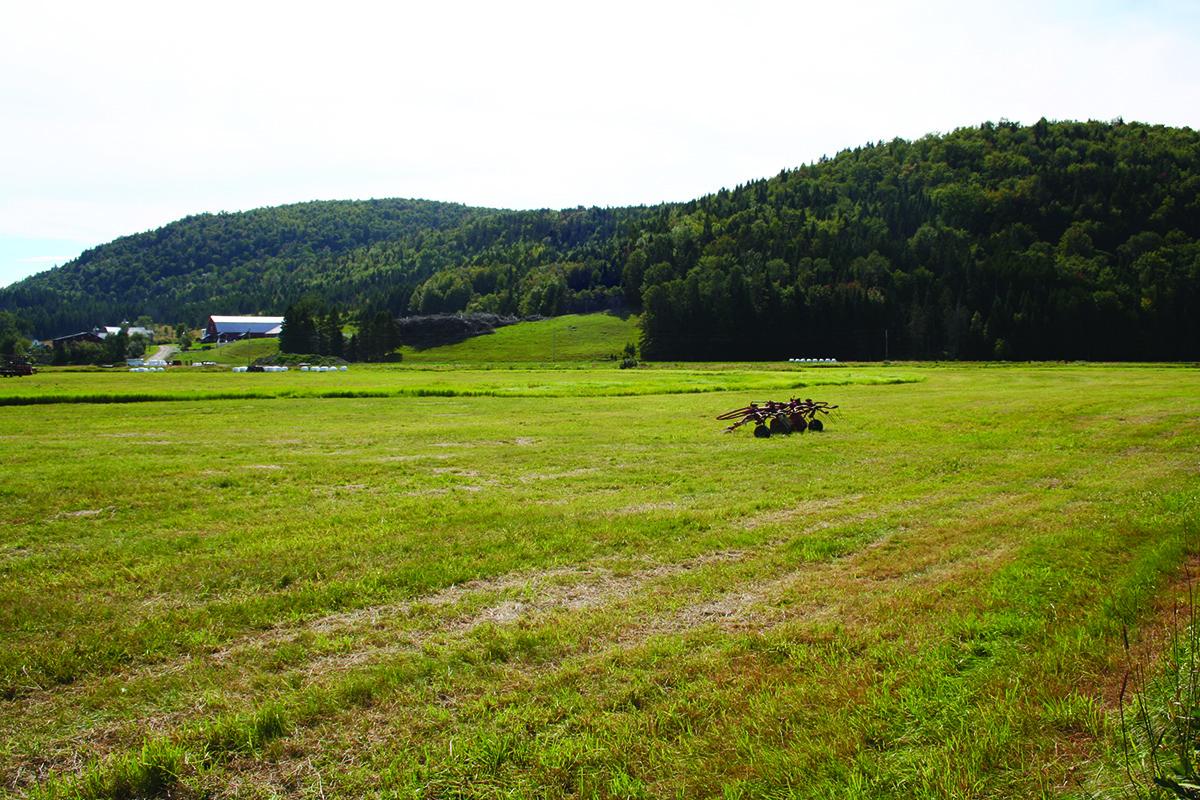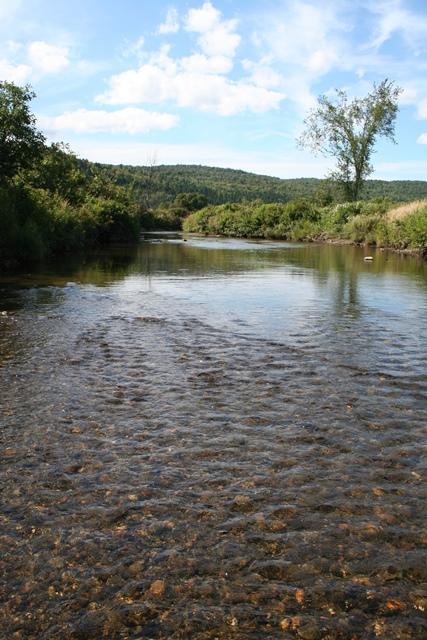Trout Habitat, Farmland and Working Forests Conserved in Pittsburg
- Tags:
- Land Conservation

The fertile fields of Maple Ridge Farm in Pittsburg are edged by working forest on one side and Indian Stream on the other. Forest Society photo.
It’s a week after the North Country Moose Festival and Roy and Laurel Amey’s barn in Pittsburg is still decorated for their annual open house, when visitors tour the farm, listen to live music and eat pie. Inside the barn, pumpkins and flowers still look festive among displays of antique farming tools, wagons and logging equipment. Outside the barn, a lawn chair looks inviting, with more like it out by the pool, but it’s highly unlikely you’ll see the Ameys sitting in them.

You get the feeling that that’s the way they want it, that making it “look pretty” means maintaining and improving for a purpose beyond aesthetics, and sure enough, Roy backs up that assumption. “If it falls to shambles, what have you left behind for the next family? All the people before me were able to farm here, raise families and pass it on. When I go – if I have to – I want it in the best condition for the next generation,” he said.

One easement covers 262 acres of Maple Ridge Farm, which is located close to the Connecticut Lakes and the Quebec border. The land includes roughly two-thirds of a mile along Indian Stream, an eastern brook trout fishery that is a focus area for habitat protection and restoration by Trout Unlimited, one of many partners in the easement purchases.

Frontage on both Indian Stream and the Connecticut River makes this land an ecological standout that attracted the funding support of many other organizations that partnered with the Forest Society to acquire the easements. They include the N.H. Land and Community Heritage Investment Program (LCHIP), the Open Space Institute’s Transborder Fund, the Russell Farm and Forest Conservation Foundation, the Hunt Foundation, three local chapters and the statewide N.H. Council of Trout Unlimited, and private contributors.
The conservation of this land adds to the large mosaic of protected lands in the area, including Roy’s brother John Amey’s farm and forest land (where both Ameys grew up) just south of Maple Ridge Farm. Also close by is the 171,000-acre Connecticut Lakes Headwaters tract conserved by a statewide coalition in 2003. That easement protects Indian Stream north of the Amey land. Other blocks have been added since then, including the Forest Society’s Washburn Family Forest, directly across the Connecticut from the Amey easements. The conservation of land across the border in Canada, including the 13,000 Mount Hereford Forest, further strengthens this region’s ecological importance to wide-ranging wildlife species.
The easements will ensure that the land can never be developed and will remain open for hunting and fishing access as well as for other light recreation. The Ameys don’t hunt or fish, but they do strongly support New Hampshire’s tradition of open, unposted land.
“People come by and tell me what a good time they had fishing,” Roy said. “What would it be like if everyone barred their land? I say let people enjoy what I call a beautiful place, let them have a place to walk on it, hunt on it, fish on it, and just enjoy it.”
Both Roy and Laurel Amey grew up in the Indian Stream Valley, but on nearby farms, not Maple Ridge. Their farming roots go back three generations, and Maple Ridge Farm connects both of their family histories in a way that makes it seem impossible that they would live anywhere else.
The house and barn were built in 1917 but originally sat some 10-12 miles away across the valley on land that is now at the bottom of Lake Francis. That farmland once belonged to Roy’s great grandparents. After Roy’s great grandfather John T. Amey died, Roy’s great grandmother sold the land, which was then sold again to Laurel’s great grandfather, Pat Gray. Members of the Gray family still owned it in the 1930s when the Army Corp of Engineers took the land by eminent domain in order to build Murphy Dam, which would flood the farm and others like it and create Lake Francis.
The Grays took the Army Corp’s offer to move their farmhouse and barn to their present location at Maple Ridge Farm, where Laurel’s grandparents and then parents farmed. Roy Amey grew up on the farm next door. When Roy was 18 and dating Laurel, with a down payment saved from milking and cutting pulpwood for neighbors, he bought Maple Ridge from Laurel’s grandmother.
It’s been the Ameys’ home ever since, and they have raised four children there and now have six grandchildren.
Roy and Laurel have both worked both on and off the farm. Laurel is retired from working at a nursing home. Roy runs a logyard down the road from the farm that he started in the ‘80s after working in the cement business, trucking and road construction before that. Now, the logyard is busy as ever, they raise 35-36 acres of hay and are up to 35 beef cows and counting, thanks to granddaughter Kassandra’s interest in farming.
“Over the last 12 years we’ve increased and increased… a lot of it is because of Kassandra. She wanted more animals and never wanted to sell any of them,” Roy said.
The cows often graze up along the wooded hillside behind the farm buildings. One early fall day, Roy rode up the hill on the John Deere Gator, climbing until he and a visitor were high enough to see across the Indian Stream Valley all the way to Lake Francis, where both Roy and Laurel’s great grandparents once farmed. Forested hilltops surrounded the valley, save for one that had been cleared for development.
“I would turn over in my grave if there was ever a hotel up here overlooking farmland,” Roy said of his hillside. Fortunately, the conservation easements have prevented that future, and though he may not rest in his lawn chair anytime soon, knowing that his land legacy is already in place brings another form of rest.
“As you get older you see what’s been destroyed, developed, changed,” he said. “I want this place to stay beautiful.”
